Potrebujeme váš súhlas na využitie jednotlivých dát, aby sa vám okrem iného mohli ukazovať informácie týkajúce sa vašich záujmov. Súhlas udelíte kliknutím na tlačidlo „OK“.
ASTM D4327-11
Standard Test Method for Anions in Water by Suppressed Ion Chromatography
Automaticky preložený názov:
Štandardná skúšobná metóda pre aniónov vo vode vypnutý iónovou chromatografiou
NORMA vydaná dňa 1.3.2011
Informácie o norme:
Označenie normy: ASTM D4327-11
Poznámka: NEPLATNÁ
Dátum vydania normy: 1.3.2011
Kód tovaru: NS-26854
Počet strán: 12
Približná hmotnosť: 36 g (0.08 libier)
Krajina: Americká technická norma
Kategória: Technické normy ASTM
Kategórie - podobné normy:
Anotácia textu normy ASTM D4327-11 :
Keywords:
anions, drinking water, ion chromatography, reagent water, wastewater, Anions content, Bromide (ion) analysis, Chloride analysis--water applications, Fluoride (ion) analysis, Halide (ion) content, Inorganic compounds--water, Ion chromatography (IC), Nitrate (ion) analysis, Organic compounds--water, Phosphate (ion) analysis, ICS Number Code 71.040.40 (Chemical analysis)
Doplňujúce informácie
| Significance and Use | ||||||||||||||
|
Ion chromatography provides for both qualitative and quantitative determination of seven common anions, F−, Cl−, NO2−, HPO4−2, Br−, NO3−, and SO4−2, in the milligram per liter range from a single analytical operation requiring only a few milliliters of sample and taking approximately 10 to 15 min for completion. Additional anions, such as carboxylic acids, can also be quantified. Note 2—This test method may be used to determine fluoride if its peak is in the water dip by adding one mL of eluent (at 100× the concentration in 8.3) to all 100-mL volumes of samples and standards to negate the effect of the water dip. (See 6.3, and also see 6.4.) The quantitation of unretained peaks should be avoided. Anions such as low molecular weight organic acids (formate, acetate, propionate, etc.) that are conductive coelute with fluoride and would bias fluoride quantitation in some drinking waters and most wastewaters. The water dip can be further minimized if measures are taken to remove carbonic acid which remain in the eluent after suppression using carbonate based eluents. There is no water dip if hydroxide eluents are used. Anion combinations such as Cl−/Br− and NO2−/NO3−, which may be difficult to distinguish by other analytical methods, are readily separated by ion chromatography. |
||||||||||||||
| 1. Scope | ||||||||||||||
|
1.1 This test method covers the sequential determination of fluoride, chloride, nitrite, ortho-phosphate, bromide, nitrate, and sulfate ions in water by suppressed ion chromatography. Note 1—Order of elution is dependent upon the column used; see Fig. 1. |
||||||||||||||
| 2. Referenced Documents | ||||||||||||||
|
Podobné normy:
Historická
15.6.2011
Historická
1.9.2012
Historická
15.11.2008
Historická
1.10.2008
Historická
1.9.2011
Historická
1.4.2011


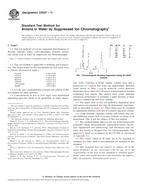
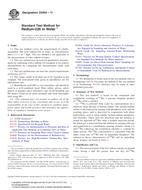 ASTM D3454-11
ASTM D3454-11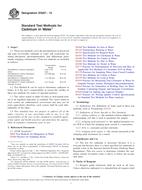 ASTM D3557-12
ASTM D3557-12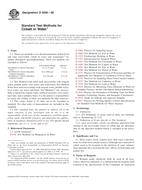 ASTM D3558-08
ASTM D3558-08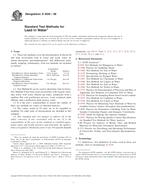 ASTM D3559-08
ASTM D3559-08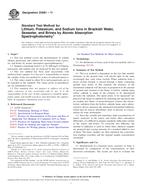 ASTM D3561-11
ASTM D3561-11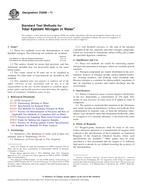 ASTM D3590-11
ASTM D3590-11
 Cookies
Cookies
